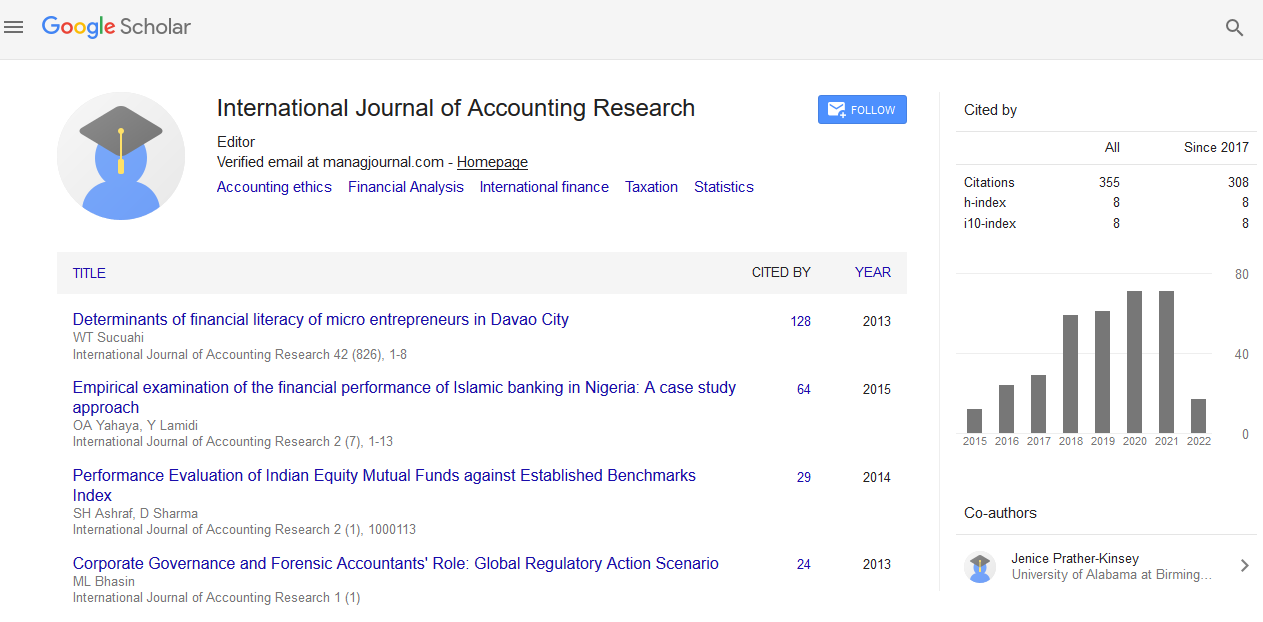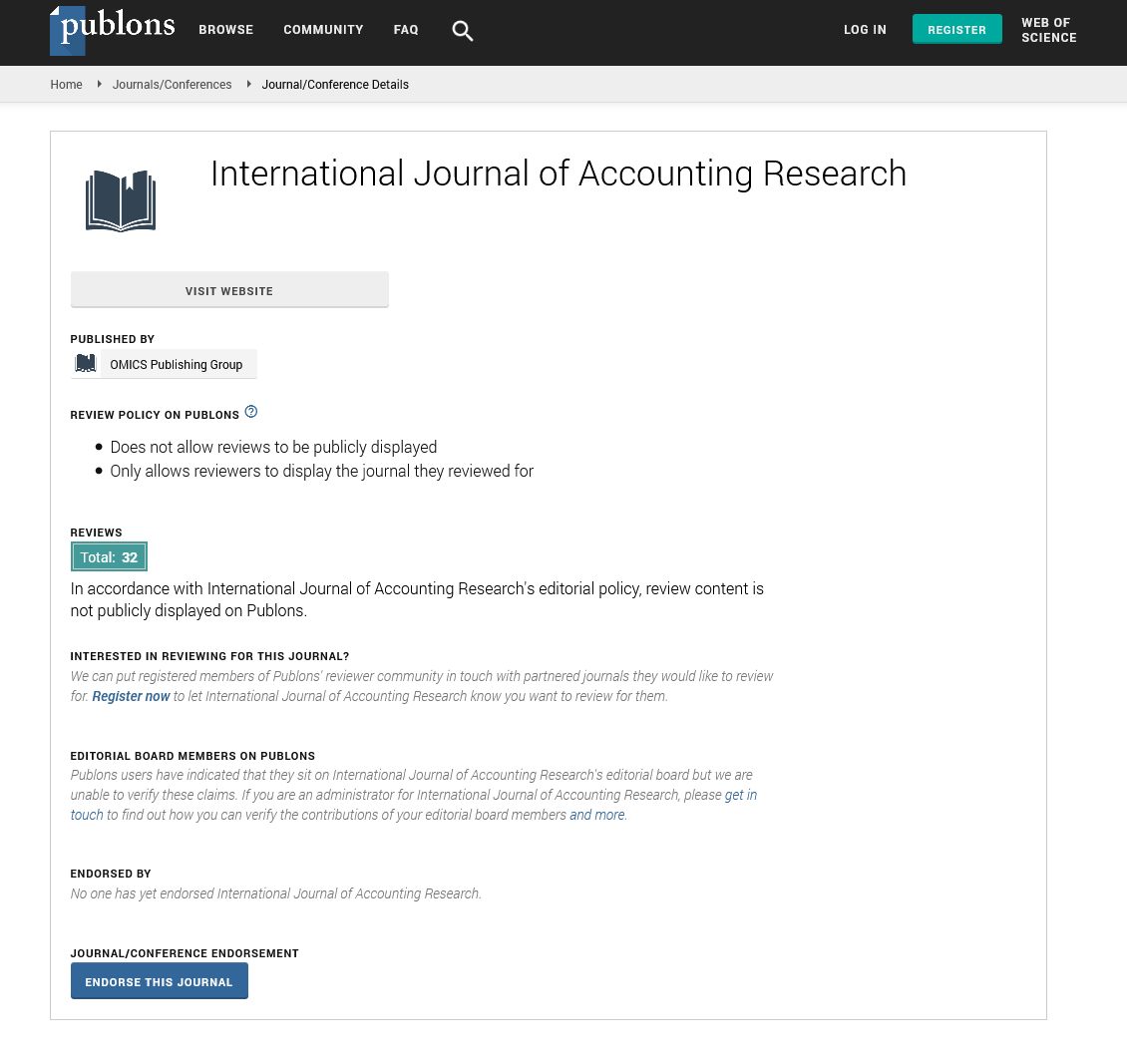Indexed In
- Open J Gate
- RefSeek
- Hamdard University
- EBSCO A-Z
- Scholarsteer
- Publons
- Euro Pub
- Google Scholar
Useful Links
Share This Page
Journal Flyer

Open Access Journals
- Agri and Aquaculture
- Biochemistry
- Bioinformatics & Systems Biology
- Business & Management
- Chemistry
- Clinical Sciences
- Engineering
- Food & Nutrition
- General Science
- Genetics & Molecular Biology
- Immunology & Microbiology
- Medical Sciences
- Neuroscience & Psychology
- Nursing & Health Care
- Pharmaceutical Sciences
Commentary - (2022) Volume 10, Issue 2
Enterprise Shareholding Reform in an Economic System
Federic Welch*Received: 01-Feb-2022, Manuscript No. IJAR-22-15963; Editor assigned: 03-Feb-2022, Pre QC No. IJAR-22-15963 (PQ); Reviewed: 17-Feb-2022, QC No. IJAR-22-15963; Revised: 21-Feb-2022, Manuscript No. IJAR-22-15963 (R); Published: 28-Feb-2022, DOI: 10.35248/2472-114X.22.10.263
Description
Shareholders, also called stakeholders, are individuals, companies, or institutions that own at least a portion of a company's shares and are called shares. Shareholders are essentially owners of the company and therefore benefit from the success of the company. These rewards are provided in the form of stock valuations or increased monetary gains paid as dividends.
Shareholder influence over a company is determined by ownership. The shareholders of a company are legally separated from the company itself. They are generally not liable for company liabilities and it is said that shareholders' liability for company liabilities is limited to outstanding stock prices unless guaranteed by the shareholders. The company does not need to record the actual owner of interest, only the owner entered in the register. If more than one person is recorded as a stakeholder, the first person in the record is considered the stakeholder's administrator and all communications and communications with the company are made with that person.
Shareholders may have acquired shares in the primary market by joining an IPO and thereby providing capital to the company. However, most shareholders buy shares in the secondary market and do not directly capitalize the company. Shareholders may be granted special privileges depending on the stock class. The board of directors of a company usually operates the company for the benefit of shareholders.
Shareholders are also considered to be a subset of shareholders that may include those who have a direct or indirect interest in the entity. For example, employees, suppliers, customers, communities, etc. are usually considered stakeholders because they add value and are influenced by the company.
A beneficiary shareholder is an individual or group that has a beneficiary right from the ownership of the shares, and a designated shareholder is an individual or group that is registered as an owner in the company's membership register when actually acting on behalf of that person. It is a group. Or at the beneficiary's direction, whether disclosed or not.
In accordance with applicable law, company legislation, and shareholder agreements, shareholders may have the following rights:
• Sell shares.
• Vote for the directors nominated by the board of directors.
• Appoint a board member (although this is actually very difficult due to the protection of the minority) and propose a shareholder resolution.
• Vote for mergers and amendments to the Articles of Incorporation.
• About dividends when declared.
• For accessing specific information. For public trading companies, this information is usually available for public use.
• Appeals the company to violate the committee obligation.
• Acquire new shares issued by the company.
• Voting and File Shareholder Solutions.
• Vote for business proposal.
• Assets remaining after liquidation.
A natural or legal person that owns the common stock of a company (commonly known as common stock in the United States) is often referred to as a common shareholder. This is the most common type of stock. Common shareholders have the right to influence decisions affecting the company by attending company general meetings and electing directors and can initiate class action, if necessary.
A preferred stockholder is an owner of preferred stock (commonly known as preferred stock in the United States). They receive a fixed-proportional dividend, paid in order of precedence over dividends paid to common stockholders. Preference shareholders usually do not have voting rights in the company.
Citation: Welch F (2022) Enterprise Shareholding Reform in an Economic System. Int J Account Res. 10:263.
Copyright: © 2022 Welch F. This is an open access article distributed under the terms of the Creative Commons Attribution License, which permits unrestricted use, distribution, and reproduction in any medium, provided the original author and source are credited.


